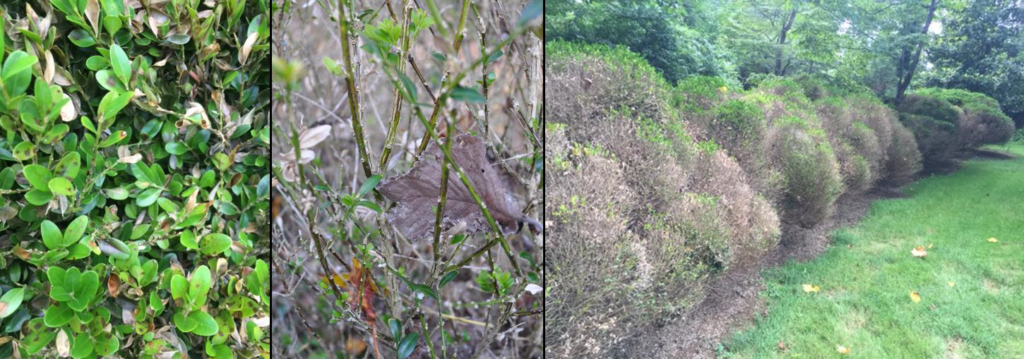Safeguarding Boxwoods
Editor’s note: This is a timely post on an important topic. We are reprinting it with permission from the authors, noted below.
Mind Your Holiday Decorations: Safeguarding Your Boxwoods from Boxwood Blight
Guest blog post by Chuan Hong, Ping Kong and Xiao Yang, Hampton Roads Agricultural Research and Extension Center
Mike Likins, Adria Bordas, Kate Robbins, Virginia Cooperative Extension — Chesterfield, Fairfax, and James City counties
Norm Dart, Debra Martin, Virginia Department of Agricultural and Consumer Services
It’s that time of year to get the house decorated for the holiday season. Do you know that boxwood greeneries and decorations could carry the boxwood blight pathogen to your property, destroying precious boxwood plantings that your family has had for generations and threatening those of your neighbors? This is what happened to a Williamsburg neighborhood during the holiday season of 2015.
As usual, the Christmas party with the neighbors was a lot of fun and all used greeneries and decorations were placed by a trash can after the New Year. A few months later, boxwood blight symptoms first showed up on an English boxwood bush near the trash can. The disease symptoms included brown leaf spots, black streaking on stems, and defoliation. This disease quickly spread to 60 English boxwoods in the backyard (60+ years old) and destroyed the entire planting by July of 2016. At the same time, the disease was also seen impacting the boxwoods on neighboring properties.
The devastating loss of the boxwood plantings to the property owners was both economical and emotional. To prevent the pathogen from further spreading, they removed all the boxwoods from their property and worked with the local fire department to burn them on-site, which was another substantial cost in time and money. The overall impact on the neighborhood and nearby historic boxwood plantings is unknown at this time.
How to Prevent Boxwood Blight
How can you prevent such a devastating incident from occurring again in the future?
Here are some recommendations:
First, it is advisable to purchase and use non-boxwood plant materials for fresh-cut greenery decorations. This is particularly important for homeowners, private and public institutions with boxwood plantings on their properties.

Boxwoods with boxwood blight. See brown leaf spots (left), black streaking on stems (middle), and defoliation (right).
Second, if fresh-cut boxwood greenery is highly desired, homeowners, private and public institutions must be sure to verify boxwood materials used are NOT infected with the boxwood blight pathogen. These practices include, but are not limited to, checking with the vendor to determine if:
(a) The greenery producers are located in areas known NOT to have boxwood blight
(b) The greenery producer’s materials were from his own production facility or another grower(s) and
(c) His own boxwood production facility or other growers who supplied the boxwood materials have enrolled in the Boxwood Blight Cleanliness Program.
Third, when the holiday season is over, all greenery decorations need to be disposed of properly — double bagging them immediately then throwing in the trash can to be taken to the landfill without delay to avoid any unnecessary complications.
Fourth, use 70 percent alcohol or Lysol Spray Brand III with 58 percent alcohol to sanitize everything that has been in contact with the greeneries and decorations. As noted in the Williamsburg neighborhood, any accidental pathogen introduction will have tremendous impact on your own boxwood plantings, your neighbors’ and the communities in which you reside. Thus, a community effort needs to be made to safeguard boxwood plantings in the Commonwealth of Virginia and beyond.
Update: If you are wondering what to do if your boxwoods are already infected with boxwood blight, Virginia Cooperative Extension has a good resource information page with best management practices.
